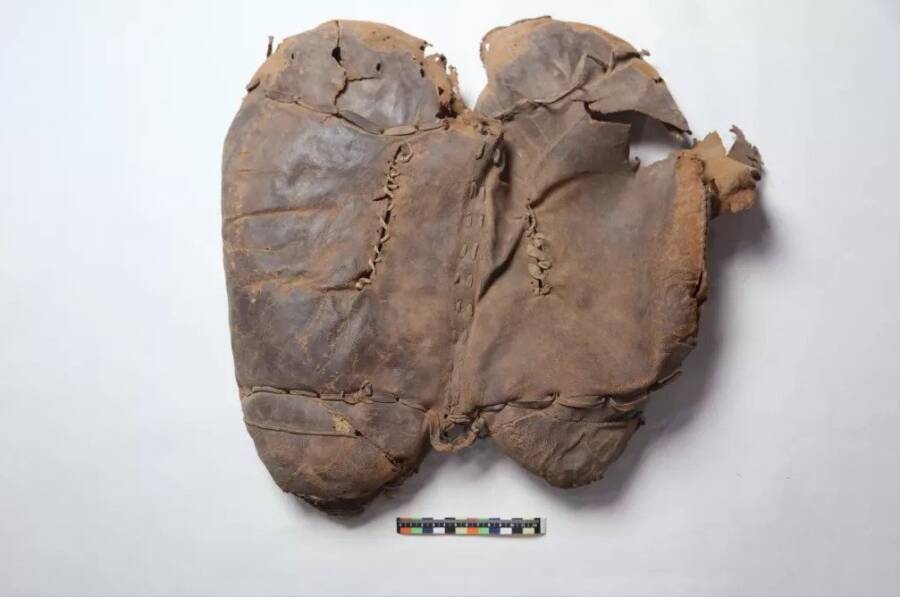The leather saddle, discovered in an ancient cemetery in northwest China, was made between 724 and 396 B.C.E.

Patrick WertmannThe discovery of the saddle in a woman’s grave challenges long-held ideas about who rode horses in ancient times.
While excavating a tomb in Yanghai — in the Turpan Basin of China’s Xinjiang Uygur Autonomous Region — archaeologists came across the grave of a woman. To their surprise, they also found that she was posed sitting on a leather saddle. Now, archaeologists believe that this saddle may be the oldest ever discovered.
According to a study published in Archaeological Research in Asia the saddle is made of two cowhide cushions. Inside, it’s stuffed with straw, as well as deer and camel hair. Radiocarbon dating suggests that the saddle was made almost 3,000 years ago, between 724 and 396 B.C.E.
“This places the Yanghai saddle at the beginning of the history of saddle making,” Patrick Wertmann, an archaeologist at the University of Zurich and the study’s lead author, explained to Live Science.
Horses played an important role in early human history, but it’s unclear when the first saddles emerged. As Live Science reports, horses were first domesticated and used for milk and meat some 6,000 years ago and were perhaps ridden by people for the first time some 5,000 years ago.
“Still,” the study’s authors note, “the intriguing question of when and where horse-riding and the use of saddles started is far from resolved.”

The British MuseumA Mesopotamian terracotta plaque depicting horse riding from circa 1750 B.C.E.
As their study notes, there are examples of horseback riding in ancient art — just not with saddles. A Mesopotamian terracotta plaque from circa 1750 B.C.E., considered the earliest pictorial evidence of horse riding, shows a rider with reins and a whip but no saddle. Likewise, a horseback rider depicted on the tomb of Egyptian pharaoh Horemheb (who ruled between 1319 and 1292 B.C.E.) appears to ride bareback with reins and a whip.
Horseback riding with saddles, Live Science reports, likely emerged around the mid-first millennium B.C.E. in Central Asia. At this time, Wertmann explained that “riders began to care more about comfort and safety, and also the health of the horses.” Plus, saddles allowed riders to cover more distance, which in turn led to more interactions with other people.
The saddle found in Yanghai appears to be one of these very early saddles and far predates other known ancient examples. Saddles from the Scythians, for example — warlike nomads who roamed the western and central Eurasian Steppe — date between the fifth and the third centuries B.C.E.

Patrick WertmannThe saddle, seen in the center of the frame, was placed alongside the woman’s body as if she were riding it.
So who exactly was the woman buried with it?
Though many questions about her remain, archaeologists believe they know some things about her identity. The cemetery they excavated in Yanghai likely belonged to people from the Subeixi culture, of which the woman was presumably a part. Live Science reports that, unlike the nomadic Scythians, the Subeixi would have used horses to monitor herds of animals.
The woman, dressed in a hide coat, woolen pants, and leather boots, likely played a role in her society as a herder. This indication challenges historical assumptions about who was riding horses in ancient times, as horseback riding is mostly depicted as a male occupation related to war.
For now, plenty of questions remain about both the saddle and the woman. But the discovery sheds some fascinating light on the intertwined history of humans and horses.
After reading about the ancient saddle found in a woman’s grave in China, discover the story of Lady Dai, a Chinese mummy who is one of the best preserved mummies in the world. Or, delve into the strange story of the 1,400 year old headless horse discovered in a grave in Germany.





